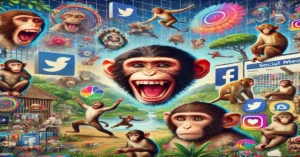Have you ever spotted a black squirrel darting across your backyard or park? These captivating creatures are nature’s little enigmas, standing out in a world dominated by their more common gray and brown relatives. Black squirrels have intrigued wildlife enthusiasts and casual observers alike with their striking appearance and unique behaviors. As they flit through trees with their glossy coats glistening in the sunlight, one can’t help but wonder about the mysteries that surround these fascinating rodents.
From their origins to cultural significance, black squirrels offer a rich tapestry of stories waiting to be explored. This blog post will delve into various aspects of these remarkable animals—from how they differ from other squirrels to where they’re found—and uncover what makes them such an extraordinary part of our natural world. Whether you’re a seasoned animal lover or just curious about local wildlife, join us on this journey into the enchanting realm of black squirrels!
Description
Black squirrels are a striking variant of the familiar tree squirrel, easily recognized by their glossy black fur. This coat is more than just a fashion statement; it serves as an adaptation to various environments. Their bushy tails, large eyes, and agile bodies make them adept climbers and foragers.
Adult black squirrels typically weigh between 1 to 1.5 pounds and measure around 18 to 24 inches from nose to tail. Their size can vary depending on habitat and food availability, but they generally share similar dimensions with gray squirrels.
One distinctive feature is their darkened ears and paws which contrast sharply against their rich fur. These characteristics help them blend into dense foliage while searching for nuts or evading predators.
When seen in motion, black squirrels display playful antics that can be both entertaining and captivating. They leap gracefully from branch to branch, showcasing agility that makes them well-suited for arboreal life.
Differences with non-melanistic squirrels
Black squirrels stand out due to their striking appearance, a result of melanism. This genetic variation gives them dark fur, contrasting sharply with the lighter shades found in many non-melanistic squirrels. While both types share similar body structures and sizes, the color difference is immediately noticeable.
Behaviorally, black squirrels may exhibit unique traits compared to their lighter counterparts. Some studies suggest that black fur can enhance their ability to withstand colder climates. As a result, they might be more active during winter months when food is scarce.
Diet plays a role too; while both enjoy nuts and seeds, variations in foraging behavior have been observed between the two groups. Black squirrels tend to be bolder in seeking out food sources than gray or red squirrels.
Socially, these rodents often face different challenges within urban populations as well. Their darker coloration sometimes makes them more susceptible to predators like hawks but also offers camouflage against certain backgrounds.
Distribution
Black squirrels are primarily found in North America, particularly in the eastern and midwestern regions. They thrive in urban parks, forests, and suburban areas where food sources are abundant. Their dark fur offers a striking contrast against the vibrant green of trees and grass, making them easily recognizable.
Interestingly, their distribution isn’t entirely uniform. Black squirrels tend to inhabit areas with higher populations of gray squirrels since they share similar habitats. This overlap can lead to fascinating interactions between the two species as they compete for resources.
While black squirrels are mostly seen across Canada and parts of the United States, introduced populations have appeared elsewhere due to human activity. Some people have intentionally released or relocated these unique rodents into new environments.
In places like England and some regions of Australia, black squirrel sightings spark curiosity among locals unfamiliar with this melanistic variant. The adaptability of these creatures allows them to establish themselves even outside their native ranges when given a chance.
Benefits of black fur
The striking black fur of black squirrels serves several vital purposes. One notable benefit is camouflage. This dark coloring allows them to blend seamlessly into their woodland environments, providing protection from predators. In densely wooded areas, the mottled light and shadows can make it difficult for hawks and other hunters to spot these agile rodents.
Additionally, black fur may offer an advantage in temperature regulation. Dark colors absorb more sunlight, which can help keep black squirrels warm during colder months. This thermal efficiency means they can remain active longer, foraging for food even in harsher climates.
Moreover, this unique coloration might influence social dynamics among squirrel populations. Black squirrels often exhibit dominant behaviors over their lighter-colored counterparts due to their physical presence and visibility against a natural backdrop.
The genetic variation that leads to melanism contributes to biodiversity within ecosystems. Diverse gene pools are essential for resilience against diseases and environmental changes affecting animal populations.
Reproduction
Black squirrels, like their gray and red counterparts, typically breed twice a year. The primary breeding seasons are late winter and mid-summer. During these times, males engage in vigorous courtship displays to attract females. This can include chasing each other through the trees or performing elaborate acrobatics.
Gestation lasts about 44 days before the female gives birth to a litter of three to five kits. These young squirrels are born blind and hairless, relying entirely on their mother for warmth and nutrition during the first few weeks of life.
After around six weeks, the kits begin to venture out of their nest but still depend on their mother for food until they’re ready to forage independently at around eight weeks old.
As they grow older, black squirrel juveniles display playful behaviors that help them develop essential skills for survival in the wild. They learn how to climb trees adeptly and navigate various terrains while honing their natural instincts against predators.
Introduced populations
Black squirrels are not just a product of their native habitats. They have been introduced to various regions, often becoming a notable feature in urban landscapes. This expansion has sparked curiosity among wildlife enthusiasts and researchers alike.
In the United States, black squirrel populations are most commonly found in Michigan and Ohio. These areas were initially home to Eastern gray squirrels, but over time, melanistic variants made their presence known. Their adaptability has allowed them to thrive alongside other squirrel species.
Some studies suggest that introducing black squirrels can impact local ecosystems. For instance, they may compete with existing populations for food resources and nesting sites. This competition can alter the dynamics of neighborhoods where they settle.
Interestingly, communities often embrace these charming rodents as part of their identity. Cities like London even celebrate black squirrels with festivals and events dedicated to them. It’s fascinating how these introduced populations have woven themselves into the fabric of local culture while continuing to be a topic of ecological study.
In culture
Black squirrels have made their mark in various cultures around the world. They often symbolize mystery and adaptability due to their unusual appearance. Many people find them captivating, which has led to numerous local legends and folklore surrounding these unique rodents.
In some regions, black squirrels are seen as good luck charms. Communities celebrate sightings of these creatures, believing they bring fortune and prosperity. This cultural significance enhances their allure and fosters a deeper appreciation for nature’s diversity.
Artistic expressions also embrace the charm of black squirrels. They frequently appear in paintings, illustrations, and even digital art as symbols of whimsy or curiosity. Their striking fur color makes them an attractive subject for artists who wish to capture the beauty of wildlife.
Social media platforms buzz with photos and videos showcasing black squirrels’ playful antics. These clips often go viral, further embedding the animals into popular culture while inspiring conservation efforts among those who admire their uniqueness.
Literature
Black squirrels have captured the imagination of many writers throughout history. Their striking appearance and elusive nature make them intriguing subjects in literature. From fables to poetry, these unique rodents often symbolize adaptability and resilience.
In folklore, black squirrels are sometimes viewed as omens or mystical creatures. They appear in stories as tricksters or symbols of cunning intelligence. These narratives highlight their ability to thrive in diverse environments, echoing human struggles for survival.
Modern literature also embraces black squirrels, celebrating their unique charm. Authors use them to represent themes of individuality against conformity. This allows readers to relate their personal experiences through the lens of a humble rodent.
Children’s books frequently feature friendly black squirrel characters that teach valuable lessons about friendship and community. Such portrayals play a crucial role in shaping perceptions of these animals as relatable companions rather than just wildlife curiosities.
Conclusion
The black squirrel stands out in the animal kingdom, captivating nature lovers and curious observers alike. Its unique coloration not only adds an intriguing twist to the common image of a squirrel but also sparks interest in its behavior and adaptations. As we explore the differences between melanistic squirrels and their lighter counterparts, it’s clear that these animals have fascinating features worth studying.
Their distribution across North America reveals how adaptable they are to various environments. The benefits of their distinctive fur extend beyond aesthetics; it plays a role in thermoregulation and camouflage. Furthermore, understanding their reproductive habits offers insight into population dynamics within urban settings where they thrive.
The introduction of black squirrels into new areas has created diverse ecosystems, showcasing how human activity can influence wildlife populations. Culturally, black squirrels symbolize uniqueness and resilience; they’ve made appearances in folklore and art, adding richness to our shared narratives.
Literature has often highlighted these charismatic creatures as symbols or characters reflecting deeper themes about nature. Their presence reminds us that even among familiar species like squirrels, there is always something special waiting to be discovered.
Black squirrels are more than just rodents with a unique appearance—they represent adaptability and resilience within nature’s tapestry. Through continued exploration of this remarkable creature’s life cycle, behaviors, culture references, and ecological significance, we deepen our appreciation for biodiversity surrounding us every day.









